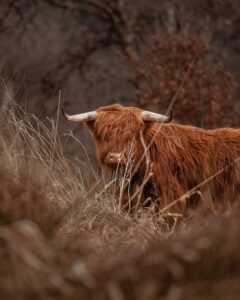
Our Trustee Ciaran O’Brien explains the important role that the newly arrived Highland Cows have in conservation grazing Middle Park here at Penllergare
Many of you will, by now, be aware of our newly arrived highland cattle grazing on Middle Park. They are part of a small herd owned by a group of graziers who move their animals between a number of sites around Swansea. “Our” cattle will move next to the Gower Commons, probably in May and we hope to have further animals grazing Middle Park a little later in the year.
Our aim is to establish and maintain a biodiverse grassland habitat in Middle Park.
The early botanical diversity seen soon after the silt was deposited here has, I believe, diminished over the ensuing years and with little or no active management and the likely highly enriched nature of the silt itself, we’ve seen the build-up of a thick dense sward, almost impenetrable in summer time.
In the absence of management, the area will revert to woodland.
Management alternatives include grazing or mechanical cutting or some mixture of both.
If mechanical cutting is used, then this should include removal of the cut material, which otherwise, if left on site, continues to enrich the ground. This, in turn, encourages highly competitive species such as grasses, thistles and nettles to the detriment of less combative wild flower species, which tend to do better on impoverished soils. The previous mechanical cuts done on Middle Park have not included removal of “arisings”. Mechanical cutting has a financial cost associated with it, the “cut-and-collect” machinery is not readily available to us and there is the question of what to do with the cut material. Importantly from an ecological perspective, the previous cuts have produced a very rapid change to a uniform sward height – this not ideal.
Conservation grazing is a well-established and widely practised method of grassland management, essentially seeking to emulate the sort of farming practices that contributed to the hay and flower-rich meadows, which have virtually disappeared from the countryside with the advent of increasingly intensified farming practices. An internet search for “conservation grazing” will provide a range of examples, often from Wildlife Trust groups, National Trust or the RSPB.
Conservation grazing, like most aspects of conservation is not an exact science, its outcomes are not entirely predictable, its not a “quick fix” and we must guard against over-grazing and excessive poaching of pond edges, for example. However, what we should see is the emergence of a diversity of sward heights and micro-habitats, resulting not only from the cattle’s grazing behaviour but also from the impacts of them lying and rolling on the ground, the creation of areas of bare ground through trampling and, of course, the presence of their dung, which has its own ecology.
Our aim for Middle Park to be a biodiverse grassland, is not just about the flora but also about the insects, birds and mammals that should benefit from the slow evolution of a multitude of diverse micro habitats that we hope the cattle will help engineer for us
Photograph by Donna Jones